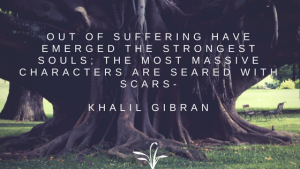I was honored with the experience of working with kids in some pretty intense treatment settings for 14 years. During that time I heard and saw the aftermath of a lot of trauma and pain and remember commenting to my mentor, “It’s like trying to catch snowflakes before they melt. You just don’t know which ones are going to make it so you try equally hard with all of them”.
I saw some kids, a lot of kids, struggle with being okay in the world. I saw others who were able to take time to heal, work through their pain, and then seemed to just take off and soar.

I wanted to understand, and still do – why do some people grow beyond their former selves as a result of struggling through trauma and not others? Can we nurture this phenomenon somehow?
What is Post Traumatic Growth?
The term “post-traumatic growth” has been around since the mid-1990s and was coined by the Posttraumatic Growth Research Group. The story, however, of people not only overcoming extreme hardship and adversity but growing beyond their former, “pre-trauma” selves has been present throughout history.
Post Traumatic Growth describes people who not only survive trauma but who go beyond and thrive.
According to the American Psychological Association, Post Traumatic Growth involves a positive response in these five areas:
- Appreciation of life
- Relationships with others
- New possibilities in life
- Personal strength
- Spiritual change
This is not, according to Kanako Taku, Ph.D. and Kobe earthquake survivor, the same thing as resiliency. Resiliency is about one’s ability to bounce back. Someone who is already resilient may suffer a trauma and be able to recover after a period of struggle.
Post-traumatic growth addresses what can happen when someone who isn’t necessarily resilient by nature experiences a trauma. Their core beliefs are challenged, they struggle psychologically, and then experience growth as a result. Their worldview is changed and consequently, their lives and functioning are strengthened and improved.
Post-traumatic growth is about how a person manages or struggles with trauma, and is not directly about the trauma itself according to its conceptual founders, Richard Tedeschi and Lawrence Calhoun. An important point, in my opinion, made on the Posttraumatic Research Group’s website is that just because someone experiences growth, does not mean that they will not suffer.
Who experiences this and why?
Because the nature of trauma is so varied and can be relative to a person’s worldview at the time of the event, there are many variables when it comes to understanding this aspect of post-traumatic growth. As well, “growth” itself can be a relative term. While there is an index used for reporting on the 5 areas listed above, how do you measure growth? For this reason, there has been some criticism of this topic’s validity.
As for me, I choose to believe that post-traumatic growth is real. I’ve seen and experienced it first hand.
It seems that the answer to my question, who experiences this and why doesn’t have a detailed or concrete answer yet based on existing research. According to Tedeschi, two traits have been identified, though, that seem to predict growth after trauma: extraversion and openness to experiences.
In other words, people who are more prone to connect with others and who are more willing to reconsider their views may have a greater capacity for growth following a crisis.

Women report growth slightly more than men. As well, those in their late teens/ early adulthood who are already figuring out their worldview may be more capable of this type of growth than younger children (Tedeschi).
I’d like to offer another possibility as an answer to this question. I didn’t come up with it on my own, but it did encourage me on days when I felt doubtful about being able to help the kids I worked with in a lasting, meaningful way.
It came to me during a discussion with a very wise, very old child and adolescent psychiatrist for who I had a great deal of respect. I learned most of what I knew about helping kids from him. He was of the old school when it came to working with youth and would spend a long time just listening to them. He always encouraged, “90% listening and 10% talking when it comes to kids.” I loved that about him.
One day, sitting in his office feeling somewhat defeated, I slumped back in one of his chairs and asked him, “What is it? Why do some of them make it and go on to do great and others just don’t?” His answer: “The one thing we know for sure is that in the cases of those that do succeed, it just took one person. One person somewhere in their life to take interest and take the time to show them another way.”
Can growth be taught or nurtured?
Well, according to what I just shared above, it would seem so.
Helping someone to grow from a tragedy they have suffered is very carefully managed, however. Timing is everything and all trauma is deeply personal. While it could be helpful to let someone know who is suffering that growth is a possible outcome, it also runs the risk of minimizing what that person is experiencing at the time.
Sometimes, in the depths of a dark place, hearing that there is light and more waiting on the other side may make someone feel like the intensity of the pain they are in, right then, at that very moment, just can not be understood or validated. Sadly, not all trauma results in growth, either. Compounding someone’s pain by adding a sense of failure to their complex sea of emotions would be tragic.
In Conclusion…
Tragedy and pain are never good. And yet, some who experience these will grow beyond their former selves and lead a more rich, full existence as a result of their struggle. While there are fundamental truths we know about human nature, something I took away from my time working with kids and their families is that we are profoundly unique, complex creatures each and every one of us.
While it would be a comfort to be able to predict and somehow duplicate the phenomenon of growth in anyone who suffered trauma, there is also a purity about hoping for it equally for all who suffer. Sometimes all we can do for these individuals is give witness to their pain, wait patiently, and listen attentively for signs of readiness to take even the smallest steps toward a return to “normal life”.
Signs of moving beyond tragedy, of stepping into an even greater self as a result of the battle with pain and adversity, should be nurtured and celebrated. This may be the best thing we can do for these victories over the brutality that life can deliver. It’s these stories of human triumph that encourage, inspire, and restore faith in the human condition, and that are a gift to us all.


